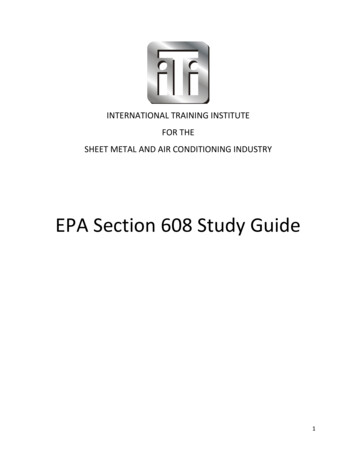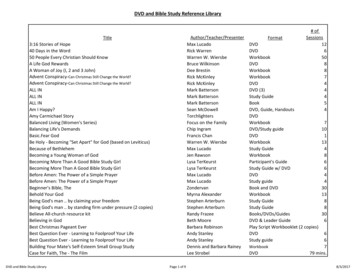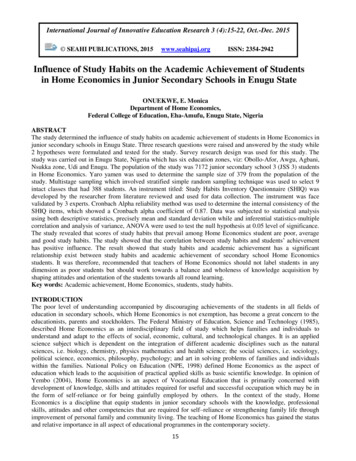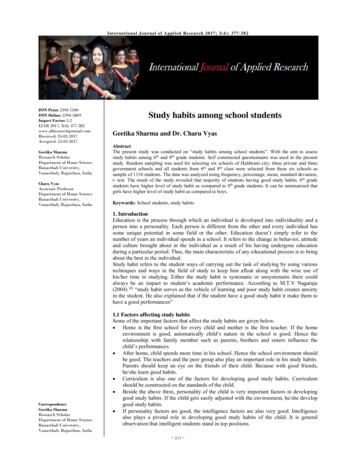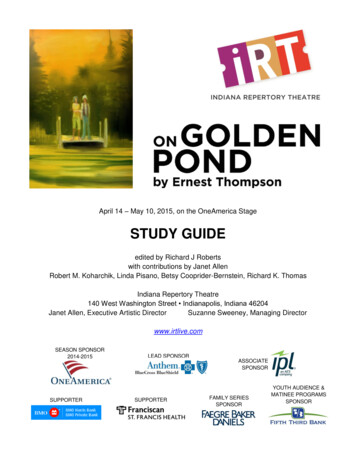
Transcription
April 14 – May 10, 2015, on the OneAmerica StageSTUDY GUIDEedited by Richard J Robertswith contributions by Janet AllenRobert M. Koharchik, Linda Pisano, Betsy Cooprider-Bernstein, Richard K. ThomasIndiana Repertory Theatre140 West Washington Street Indianapolis, Indiana 46204Janet Allen, Executive Artistic DirectorSuzanne Sweeney, Managing Directorwww.irtlive.comSEASON SPONSOR2014-2015SUPPORTERLEAD SPONSORASSOCIATESPONSORSUPPORTERFAMILY SERIESSPONSORYOUTH AUDIENCE &MATINEE PROGRAMSSPONSOR
2 Indiana Repertory TheatreOn Golden Pondby Ernest ThompsonAs Ethel and Norman return to the familiar summer ritual of their tranquil vacation home on thewater, they get a surprise guest in the form of their daughter’s young stepson-to-be. Through theeyes of three generations, we experience the labors and liveliness of a couple in the midst oftheir twilight years, and are reminded that each moment is a gift we share with those we love.Ernest Thompson’s On Golden Pond is a captivating study in character, relationships, andovercoming the past. Norman has begun struggling with memory loss, yet finds comfort inmaking new memories with his grandson-to-be. His faithful wife Ethel confronts their daughterabout her strained relationship with her father by illuminating uncomfortable moments in theirpast. On Golden Pond offers students a chance to engage in character analysis and to exploremood and tone by analyzing the significance of setting.Estimated length: 2 hours, 30 minutes, including 1 intermissionRecommended for students in grades 7 through 12.Themes, Issues, & TopicsRelationships between parents and childrenImpact of aging on one’s self-imageImportance of relationships to make life enjoyableInter-generational relationships adding to the richness of lifeStudent Matinees at 10:00 A.M. on April 22, 23, 28ContentsArtistic Director’s NoteDesigner NotesLoonsThe Real Golden PondIndiana Academic StandardsResourcesDiscussion QuestionsWriting Prompts, ActivitiesVocabularyWorks of Art – Kyle RagsdaleGoing to the Theatre34689101112131718Education SalesRandy Pease 317-916-4842rpease@irtlive.comPat Bebee 317-916-4841pbebee@irtlive.comOutreach ProgramsMilicent Wright 317-916-4843mwright@irtlive.com
Indiana Repertory Theatre 3Beneath the Surfaceby Janet Allen, Executive Artistic DirectorOn Golden Pond hits most of us in a variety of places oflonging: nostalgia for the kind of old-fashioned familyplay written in great profusion in the mid 20th century;desire for that ancestral cabin on the picture-perfectlake; yearning for unfolding weeks of summers to spendin it, nothing to do but read, fish, take walks, skinny dip,evenings on the screen porch, endless games ofcards . It sounds like a giant exhale of relief!What most of us remember about this stage and screenchestnut is the crotchety Norman and his all-forgivingwife, Ethel, in pictorial flashes of the many celebritieswho have played these roles over the years. What wedon’t tend to remember is what’s underneath. And that’swhere the play surprises us.This composite image created by designerOn Golden Pond is actually a three-generational tug ofRobert M. Koharchik from a variety ofwar that is incredibly insightful about American familysources is featured as part of the scenicculture: about adult children having difficulty finding theirbackdrop for On Golden Pond.way; about young children, the products of divorce, havingto cope with changing circumstances; and of course about the travails of aging in a culture thatdoesn’t do nearly enough to honor its elders. Despite the fact that Ernest Thompson was only28 when he wrote the play, he had tremendous insight into all three of the generations onstage.At the very heart of the play is the story of a father and daughter who somehow missed eachother—who failed to figure out how to connect and stay connected. Nothing significant causedthis fissure, just the day-to-day kinds of slights and overlooked hurt feelings that constitute manylives. They each need the other to initiate, to make a gesture . What we, as audiencemembers experience is the missed opportunities that happen to all of us when we aren’t payingfull attention to the signs.One of the great beauties of the play is its unanswered questions: Is this Norman and Ethel’slast summer on the pond? Will they see more of Chelsea in her new life? Will Billy’s attentionsspur Norman on to taking a new interest in living? Just as in life, many things remainunresolved, unfinished, like a refrain that dies away but might easily revive again. It reminds usto pay attention, not only to the beauty of the places we love, but to the beauty of the people welove, no matter their age.
4 Indiana Repertory TheatreSummer in MaineRobert M. Koharchik Scenic DesignerThe design for this production set out to accomplish two things. The first is to establish thehouse where many summers have been spent and lasting memories created by the Thayerfamily. The second is to include in the overall environment a sense of the area around the houseand give the lake a presence onstage, a view that is more than just a small glimpse outside awindow.Preliminary scenic sketch by designer Robert M. Koharchik.Betsy Cooprider-Bernstein Lighting DesignerFrom summer weeks spent on Trout Lake in northern Wisconsin in the late 1980s, I feel anostalgic affinity for the Thayers’ wooded sanctuary on the shores of Golden Pond. There isclarity in the air and a particular quality of northern light as it reflects off rippling lake water thatcan make everything look quite magical. On early morning fishing jaunts with my husband, Alan,I often felt more triumphant catching a glimpse of those iconic loons than catching perch fordinner. Later in the day, the loons’ soulful cries would beckon us down to the water’s edge asthe glow of sunset faded behind the distant tree line. Lingering at the dock, we would relive theday, wishing that time could indeed stand still. I have called upon my memories of Trout Lake toinspire choices in color, angle, intensity, and the movement of light in our very own lake housethat now sits on the IRT stage at 140 West Washington Street.
Indiana Repertory Theatre 5Linda Pisano Costume DesignerThe approach to the costumes for our production ofOn Golden Pond is not focused on period accuracy,but rather the timelessness of thestorytelling. Although clearly there is a specific era ofclothing involved, the garments should evoke asense of how each character enters this lakehouse. The clothing will reveal not only the biographyof the characters’ lives up to this point; but somecharacters, such as Norman, Billy, and Ethel, willdevelop subtly in their details over the course of theplay. The palette is controlled to imply the changing ofthe seasons. Overall, there is a very diverse range ofages, experiences, and geography among thecharacters, and the intent is that the gritty, lived-inquality of the clothing will suggest the nuances andpersonal idiosyncrasies of each character.Preliminary costume sketchesfor Ethel (left) and Norman (below)by designer Linda Pisano.Richard K. Thomas Sound DesignerVery few plays devote their titles to location. OnGolden Pond is one such play. A pond in Maine.Set over five months that traverse what might bethe last summer spent there by Norman andEthel. What does that place sound like? How dothose sounds evoke that potentially final journey?Perhaps more importantly, another journey takesplace: the journey of self-discovery, even in ourtwilight years. What does that journey sound like?And who better than Carrie Newcomer to helpguides us through it? After 18 albums, thisIndiana native has become something of an iconacross the country and around the world. RollingStone describes her impact as “Rapturouslytuneful,” adding that “Newcomer’s material asksall the right questions and refuses to settle foreasy answers.” Carrie’s music scrupulouslysearches for “the sacred in the ordinary” andhelps us to discover those simple joys in Normanand Ethel’s journey.
6 Indiana Repertory TheatreThe Cry of the LoonThe silence of the predawn hours in the northern reaches of the Connecticut River Valley isoccasionally shattered by an unearthly tremolo cry, difficult to describe and impossible to forget- almost like a demented person laughing. The caller is a common loon, one of the oldest("most primitive") birds known.There are five species of loon, but the onemost common in New England is thecommon loon. This species spends thesummers in the northern parts of NewEngland, normally nesting along theshores of the many lakes and ponds ofNew Hampshire, Maine, and Vermont, aswell as the eastern Canadian provinces.However, because there is competition forfood, some loons can be seen diving forfish in the River. The birds then migrate tocoastal waters (from the Chesapeake Bayto the Gulf of Mexico) for the winter.Loons are large birds, with wing spans approaching four feet, but they are also relatively heavybirds so the large wings are essential. They are extremely efficient diving birds, and their legsare set well back on the body, which aids in propulsion in the water but makes navigating onland nearly impossible. A loon is vulnerable on land because it can only thrust its chest forwarda few inches and drag the legs back underneath the body. As a result, loons leave the wateronly to nest (very close to the shoreline) and to defecate.Loons feed on fish and other aquatic life. They overwinter in southern waters, primarilybecause they must have an expanse of open water (sometimes as much as 400 yards) to getairborne. They return to northern waters inthe spring, where the longer days provideample time for the biologically expensiveactivities of laying eggs and raising chicks.Loons typically produce two eggs eachyear. Incubation takes about 28 days, andthe parents share the nest duty equally.The average loon pair in New Hampshirefledges one chick each year - heat stressduring incubation and predation by largebass and raptorial birds shortly after achick hatches take their toll.
INDIANA REPERTORY THEATRE7When the chicks hatch (usually around July 4th in New England), they immediately make theirway to the nearby water and leave it only to defecate. The adults now take on the substantialchallenge of feeding the babies and themselves - diving for 30 to 50 seconds at a time,catching fish, and feeding them directly to the chicks. During the first week, a chick may crawlon to the back of a parent which is paddling along on the surface. Chicks stay very close to theparents for the first three weeks, and respond immediately to calls warning of birds (orairplanes) flying overhead by scrambling under an adult's wing. The chicks grow very rapidlyand are nearly the size of the adults within four to six weeks. They also begin to demonstrateindependence, seeking their own food, diving, and exercising their wing muscles. They retaintheir dull grey back plumage during that time, although the belly turns white.As winter approaches, the adults congregate with other adults in the region and migrate tomore southern waters. Although loons mate for life and normally return to the same territorythey occupied the previous year, a pair does not necessarily migrate together, and may not bereunited until the following year. Similarly, juveniles congregate with others in autumn andtravel together - leaving before the northern ponds and lakes are covered with ice.—Patricia Vittum, Biology Department, University of Massachusetts Amherst
8 INDIANA REPERTORY THEATREThe Real Golden PondGolden Pond is fictional. Playwright Ernest Thompson took his inspiration from Great Pond inMaine, where his family began spending summers in 1903.Great Pond is located in Kennebec County in southern Maine. The southern tip of Great Pondis about 13 miles north of downtown Augusta (the capital of Maine), and about 7 miles north ofthe Augusta city limits. The nearest towns to Great Pond are Rome, about 1 mile northwest,and Belgrade, about 3 miles south. Great Pond stretches 7 mile at its longest point and 4 milesat its widest point. It covers 8, 500 acres (13 square miles) and has a shoreline of 46 miles. Itsaverage depth is 21feet, and its deepestpoint is 69 feet. GreatPond is one of thelargest bodies ofwater in the worldnamed a pond.Although CampKoochakiyi,mentioned severaltimes in the play, isfictional, CampRunoia is a girls’camp that has beenoperating on GreatPond since 1907.
INDIANA REPERTORY THEATRE9Indiana Academic Standards Alignment GuideReading – Literature RL.1 – Read and comprehend a variety of literature independently and proficiently RL.2 – Build comprehension and appreciation of literature by analyzing, inferring, anddrawing conclusions about literary elements, themes, and central ideas RL.3 – Build comprehension and appreciation of literature, using knowledge of literarystructure and point of view RL.4 – Build comprehension and appreciation of literature by connecting various literaryworks and analyzing how medium and interpretation impact meaning Sample: 11-12.RL.2.3: Analyze the impact of the author's choices regarding how todevelop and relate elements of a story or drama (e.g., where a story is set, how theaction is ordered, how the characters are introduced and developed).o Using evidence from the play, explain the significance of the home on GoldenPond to each character in the play. How does the symbolism and meaningchange from character to character? Over time?Sample: 9-10.RL.2.3: Analyze how dynamic characters (e.g., those with multiple orconflicting motivations) develop over the course of a text, interact with other characters,and advance the plot or develop the theme.o Identify and explain the central conflict faced by Norman Thayer, and analyzehow it affects the other characters in the play. Use examples from the play tosupport your conclusions.Reading – Nonfiction RN.2 – Extract and construct meaning from nonfiction texts using a range ofco
The chicks grow very rapidly and are nearly the size of the adults within four to six weeks. They also begin to demonstrate independence, seeking their own food, diving, and exercising their wing muscles. They retain their dull grey back plumage during that time, although the belly turns white. As winter approaches, the adults congregate with other adults in the region and migrate to more .



